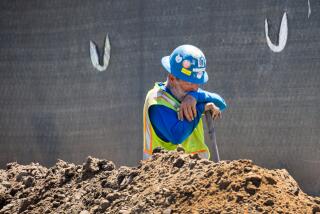As Mercury Soars, So Does Tourism
PALM SPRINGS — They’re finally ready to admit it: Summer in Palm Springs is hot--very, very hot.
For years, the tourist-dependent in this town tried to keep this hidden under their wide-brimmed hats. Weather forecasters were urged by tourism officials to avoid offensive terminology such as “sizzling,” “scorcher” and the detested “yowza!” Copywriters wrote summer ads that meticulously refrained from using “sultry,” “steamy” or “desert sun.”
So you had heard that temperatures hovered around 115 degrees? “Don’t be fooled by numbers,” city boosters would say, a precursor to the town’s summer mantra: “It’s a dry heat.”
But now they’re dusting off their thermometers.
Some do, it seems, like it hot.
“Every year, we’ve noticed an increase in summer visitors who come, not despite, but because of the heat,” said Ray Lovato, president of the Palm Springs Hotel Association.
From 1990 to July of this year, room receipts have increased 93% during the summer months, according to city tax records.
Lovato has firsthand evidence of just how powerful summer’s draw can be.
His hotel, Desert Shadows Inn, is a nudist resort that has been fully booked every weekend this summer. And on a recent morning, with 102-degree heat and a blazing sun, all 30 registered guests were merrily bobbing in the pool.
“It’s too hot to breathe,” Lovato said, “but everyone’s having a good time. And we don’t even offer summer discounts.”
For Europeans, Heat Is Novelty
At the Hyatt Regency Suites, on the town’s main drag, the swimming pool viewed through the glass door of an air-conditioned lobby was postcard perfect. The sky was poster-paint blue. The mountains shimmered in the sunlight, and a dozen vacationers lazed about the turquoise water.
But opening the door was like popping the hood on a car that has overheated in the desert. The skin prickled. Calorific waves of superheated air pushed into the human body.
Carolyn Taylor, 54, languidly draped over a pool float as the mercury hovered at 110, said she liked the high temperatures. This was the third year she and her husband and another couple had vacationed in Palm Springs in July.
“I love the heat--110, 112, that’s my optimum,” said the Fairfield, Calif., resident. “Since we’re from Northern California, we don’t get the constant heat. Here, it’s a given. We know we can stay in the pool every day.”
Asked about predictions that it would hit 120 degrees before the end of her weeklong stay, Taylor shrugged.
“Well, they do have misters,” she said, referring to the clouds of water vapor sprayed over almost every Palm Springs restaurant and pool.
Nearby, Andrew Smith of Fife, Scotland, was looking pink and overheated under a shady umbrella, but his bikini-clad wife, Louise, was two chairs away in order to place her fair skin in full sun.
“I’ve just been in the pool. I’m quite comfortable really,” said Smith, 45, in an accent usually associated with gray, foggy moors. “I like the heat.”
Later, after the sun went down but before the temperature dropped below 100, Rudi Frederickson, 38, sipped iced tea at a local Starbucks after spending a day in the sun.
“What is so unusual about enjoying the heat?” the Frankfurt, Germany, resident asked. “People use saunas and steam rooms for their health. Why not the sun? Heat is good for aches.”
Last year, a hotel association study estimated that 60% of summer visitors live within driving distance and come for off-season discounts. But the other 40%, mostly Europeans, fall into the moth-to-a-flame category.
“It’s strange, but true, that there is a growing market of people who come here for the heat,” said Bill Clawson, executive director of Palm Springs Tourism. “For people from Germany and the United Kingdom, heat is a kind of novelty.”
Things warmed up in the summer of 1991, when Palm Springs saw a 40% increase in tourism, based on hotel room records, after promotions in Germany and Great Britain, which basically ran along the lines of: “It’s hotter than blue blazes, come spend the summer.”
“It was phenomenal,” said Tom Kanarr, the city’s finance director. “Even going to the grocery store, I would bump into people from Germany and Ireland and the rest of Europe. A new market came to town.”
Since then, summer business has continued to grow. It now represents 13% of the room tax income, or $1.3 million, in a town where two-thirds of the hotels once closed for the summer.
Any increase in tourism is important when at least half of the economy is based on money that goes directly from tourists’ wallets to restaurants, hotels and entertainment, Kanarr said.
Hot Spots Are Now Alluring
If anything, folks in this pedigreed tourist town are now annoyed that they must compete with less glamorous Death Valley in attracting tourists looking for roasting boasting rights.
“Maybe they’re the hottest spot on Earth, but what’s there to do there? We have activities and heat,” Lovato said. “Besides, their temperatures are excessive.”
In these parts, what constitutes excessive heat is, of course, a matter of opinion.
Ken Irwin, owner of La Mancha Private Villas, said 110 degrees is when the locals change from long pants to shorts.
La Mancha, where Barbra Streisand and James Brolin, and Jennifer Aniston and Ice Cube (who didn’t melt) have recently been among the guests braving the heat, has more advance summer bookings this year than it has seen in more than two decades in business.
There may be nothing new under the sun in some cities, but people willing to pay upward of $280 for a room when that sun is at its hottest is a new twist for Palm Springs, Irwin said.
“Things have changed,” he said. “I still remember when all the hotels and restaurants put aluminum foil over their windows and hung up signs that said, ‘See you in October.’ ”
More to Read
Sign up for The Wild
We’ll help you find the best places to hike, bike and run, as well as the perfect silent spots for meditation and yoga.
You may occasionally receive promotional content from the Los Angeles Times.







